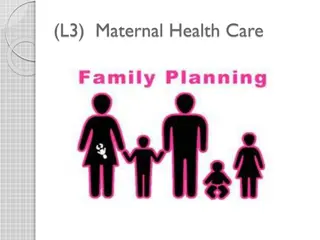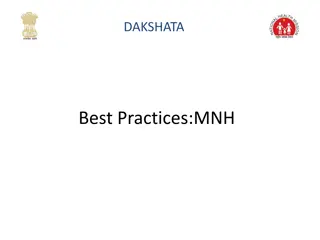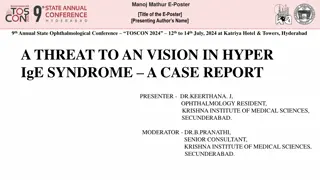Understanding Neurogenic Speech and Language Disorders in Adults
This chapter provides insight into language disorders in adults, including types of aphasia, causes such as toxins, traumatic brain injury, brain tumors, and strokes. It discusses cerebral hemorrhage, occlusive strokes, ischemic stroke, transient ischemic attacks, and cerebral thrombosis. The conten
1 views • 34 slides
Proclaiming Good News and Healing Miracles from the Book of Luke
The passages from the book of Luke narrate how the Spirit of the Lord rests on Jesus to bring good news to the poor, proclaim freedom and sight to the oppressed, and announce the year of the Lord's favor. The accounts also include miraculous healings of a woman with a hemorrhage and a young girl res
1 views • 11 slides
Progress and Challenges in PPH Prevention and Management
Presented by Michael Muthamia, the AMPLI-PPHI program aims to reduce maternal mortality by promoting the early adoption and scale-up of new PPH treatments. With a focus on heat-stable carbetocin, tranexamic acid, and misoprostol, the program drives catalytic change through evidence generation, marke
2 views • 13 slides
Maternal Health Care and Family Planning Overview
Maternal health care and family planning are essential components of reproductive health. Family planning helps individuals achieve various objectives like avoiding unwanted pregnancies, controlling the timing and number of children, and regulating pregnancy intervals. The health benefits include pr
0 views • 19 slides
Understanding constipation, scant feces, and alimentary tract hemorrhage in farm animals
Constipation in farm animals is characterized by decreased frequency of defecation and dry, hard feces. Scant feces are small quantities of feces, commonly seen in animals with stomach abnormalities. Alimentary tract hemorrhage can result from various causes, including ulcers and infestations. Hemor
1 views • 12 slides
Clinical Update on Management of Spontaneous Intracerebral Hemorrhage
This clinical update, adapted from the 2022 guideline by the American Heart Association and American Stroke Association, covers a comprehensive range of topics related to the management of patients with spontaneous intracerebral hemorrhage. It includes information on population health implications,
0 views • 38 slides
Maternal and Fetal Complications of Obesity in Pregnancy
Understanding the impact of obesity stigma as a stressor throughout the lifecourse is essential, especially concerning pregnancy. The prevalence of pre-pregnancy overweight and obesity poses significant risks, leading to various maternal complications like gestational diabetes, cesarean delivery, an
0 views • 62 slides
Understanding Hemostasis and Hemodynamic Disorders in Health
Hemostasis is crucial for maintaining the health of cells and tissues by ensuring continuous circulation of water, oxygen, and nutrients while removing metabolic waste products. Factors controlling normal hemostasis include the integrity of blood vessel walls, blood content, platelet function, and l
0 views • 14 slides
Understanding Cerebral Edema: Causes, Treatments, and Pathophysiology
Cerebral edema is a life-threatening condition that can result from various factors such as trauma, infarction, hemorrhages, or tumors. This condition can lead to increased morbidity and mortality due to hemorrhage or herniation. New advances in understanding the pathophysiology of cerebral edema ha
1 views • 28 slides
TCCC Critical Decision Case Studies: Bleeding Management Scenario
This presentation focuses on a critical decision case study in Tactical Combat Casualty Care (TCCC) involving a casualty with high amputations and ongoing massive hemorrhage. The scenario explores the challenges of managing uncontrolled bleeding in a combat situation and provides insights into the r
0 views • 139 slides
Understanding Determinants of Maternal Death: Causes, Factors, and Response
This educational session delves into the determinants of maternal death, distinguishing between causes and factors that increase the risk of maternal mortality. It covers possible determinants like hemorrhage, sepsis, and poor access to healthcare services, and discusses the Three Delays model for i
0 views • 18 slides
Anesthesia Management for Post-Tonsillectomy Hemorrhage in Children
This article discusses the epidemiology, causes, and anesthesia management of post-tonsillectomy and adenoidectomy hemorrhage in children. It covers the rates of hemorrhage following these procedures, including primary and secondary occurrences, mortality statistics, and specific factors contributin
0 views • 31 slides
Detection of Low-Grade Hemorrhages in Preterm Infants: Ultrasounds vs. MRIs
This study compares the effectiveness of head ultrasounds and brain MRIs in detecting low-grade hemorrhages in preterm infants. It discusses the incidence of intraventricular hemorrhage (IVH) in very low birth weight infants, classification of IVH, risk factors for IVH, outcomes related to IVH grade
9 views • 33 slides
Evaluation and Management of Headache in the Emergency Department
Headaches unrelated to trauma account for 2% of emergency department visits. It is crucial to differentiate between patients with life-threatening headaches and those with benign primary headaches. History and physical examination play a vital role in assessing and diagnosing patients with high-risk
0 views • 33 slides
Treatment Strategies for Hemorrhagic Stroke: Goals and Management
Short-term goals for treating hemorrhagic stroke involve rapid neurointensive care to maintain adequate oxygenation, breathing, and circulation, along with managing increased intracranial pressure and blood pressure. Long-term management focuses on preventing complications, recurrent bleeding, delay
11 views • 9 slides
Comparing Bleeding and Mortality Risks of Dabigatran vs. Rivaroxaban in Elderly Medicare Beneficiaries
A study by DJ Graham et al. compared the risks of stroke, bleeding, and mortality in elderly Medicare beneficiaries with nonvalvular atrial fibrillation treated with dabigatran or rivaroxaban. The study included over 118,000 patients and found that dabigatran was associated with a lower risk of majo
0 views • 9 slides
Lumbar Puncture: Indications, Contraindications, and Post-procedure Considerations
Lumbar puncture is a medical procedure involving the insertion of a needle into the spinal subarachnoid space to collect cerebrospinal fluid for diagnostic or therapeutic purposes. Indications for performing a lumbar puncture include suspicion of meningitis, subarachnoid hemorrhage, CNS diseases lik
0 views • 17 slides
Understanding Avian Influenza: Symptoms, Diagnosis, and Prevention
Avian influenza, or bird flu, is a viral disease affecting birds' respiratory, digestive, and nervous systems. It presents in two forms - Highly Pathogenic Avian Influenza Virus (HPAIV) and Low Pathogenic Avian Influenza Virus (LPAIV). The virus has two important surface antigens, Hemagglutinin (H)
0 views • 7 slides
Understanding Peptic Ulcers: Causes, Symptoms, and Nutritional Management
Shahid Virpatni Laxmi Mahavidyalaya conducted a presentation on gastrointestinal (GI) disorders, focusing on peptic ulcers. The content covers the etiology, symptoms, and nutritional management of peptic ulcers, emphasizing the importance of proper diet in managing this condition. Peptic ulcers, cha
0 views • 8 slides
**Understanding Portal Hypertension: Causes, Symptoms, and Treatment**
Portal hypertension is a serious condition often associated with cirrhosis. Causes include cirrhosis and non-cirrhotic conditions. Symptoms range from asymptomatic to complications like variceal hemorrhage, ascites, and splenomegaly. Preventive measures, such as nonselective beta-blockers, are cruci
0 views • 14 slides
Postpartum Hemorrhage Simulation Activity with Swim Lane Mapping
Prepare for a postpartum hemorrhage simulation activity by printing slides, setting up a floor diagram with masking tape lanes, and arranging role members. Watch instructional videos, analyze contributing factors, and place process steps on the diagram. Follow key instructions, identify key actions
0 views • 20 slides
Postoperative Hypotension: Management and Recovery Strategies
In a case of postoperative hypotension following a transurethral prostatectomy under spinal anesthesia, a 78-year-old patient presented with agitation and shivering in the PACU. Vital signs and pain scores were monitored, showing a blood pressure of 89/40, heart rate of 85/min, and respiratory rate
0 views • 16 slides
Understanding Birth Injuries in Newborns
Birth injuries in newborns can result from various factors during the birthing process, such as soft tissue injuries and head trauma. Soft tissue injuries like facial abrasions and scleral hemorrhage may occur due to causes like dystocia and forceps delivery. Nursing care involves assessing and reas
0 views • 19 slides
Innovative Healthcare Solutions Evaluation
This evaluation assesses the effectiveness of different healthcare aims: screening and managing visual impairments in stroke patients, enhancing communication between healthcare and social care services through software, and implementing AI for faster detection of cranial hemorrhage. The aims focus
0 views • 4 slides
Understanding Wound Care: Types, Healing Process, and Complications
Wound care involves managing various types of wounds such as bruises, abrasions, lacerations, and more. Understanding wound healing processes like primary and secondary intention is crucial. Factors like age, nutrition, and smoking can affect healing. Monitoring signs of healing and recognizing comp
0 views • 14 slides
Anesthesia Management for Post-Tonsillectomy and Adenoidectomy Hemorrhage
This content provides insights into the epidemiology of post-tonsillectomy and adenoidectomy hemorrhage in children, including rates and causes. It outlines a plan for anesthesia management, covering preoperative, intraoperative, and postoperative aspects. Mortality statistics after tonsillectomy an
0 views • 31 slides
Best Practices for Maternal and Newborn Health (MNH) - Essential Guidelines
Comprehensive guidelines for maternal and newborn health practices include dos and don'ts, such as perineal shaving, delayed cord clamping, exclusive breastfeeding, and more. Key measures like controlled cord traction (CCT) in a relaxed uterus and delaying the baby's first bath play crucial roles in
0 views • 11 slides
Overview of Pulmonary Hemorrhage in Infants
Pulmonary hemorrhage in infants is a severe condition characterized by bloody discharge from the upper respiratory tract or endotracheal tube, often associated with prematurity, lung complications, infections, or trauma. The etiology, pathophysiology, clinical manifestations, and diagnosis of pulmon
0 views • 14 slides
Understanding Community Vital Signs and Maternal Mortality Review Committee Findings
Explore the importance of Community Vital Signs and Maternal Mortality Review Committee in assessing pregnancy-related deaths. Learn about the factors contributing to these deaths, preventive measures, and anticipated impacts of addressing contributing factors. Delve into chains of risk, like morbid
0 views • 20 slides
Vision Threat in Hyper IgE Syndrome: A Case Report
Hyper IgE Syndrome (HIES) is a rare primary immunodeficiency characterized by elevated IgE levels and recurrent infections. Ocular involvement in HIES is uncommon, with reported cases of various eye conditions such as conjunctivitis and retinal detachment. A 17-year-old male with HIES presented with
0 views • 6 slides
Emergency Management in Cardiac Intensive Care
Information on managing emergencies in cardiac intensive care including topics like hemorrhage post-cardiac surgery, tamponade post-cardiac surgery, and control of bleeding. Details on initial steps for bleeding control, teamwork in managing hemorrhage, and diagnosing tamponade post-cardiac surgery
0 views • 16 slides






























